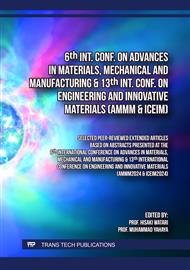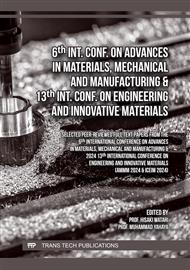[1]
M. H. Fouladi et al., "Pretreatment studies and characterization of bio-degradable and 3d-printable filaments from coconut waste," Int. J. Nanoelectron. Mater., vol. 13, no. Special Issue ISSTE2019, p.137–148, 2020.
Google Scholar
[2]
I. Elfaleh et al., "A comprehensive review of natural fibers and their composites: An eco-friendly alternative to conventional materials," Results Eng., vol. 19, no. July, p.101271, 2023.
DOI: 10.1016/j.rineng.2023.101271
Google Scholar
[3]
K. Deshmukh, M. B. Ahamed, S. K. K. Pasha, R. R. Deshmukh, and P. R. Bhagat, "Highly dispersible graphene oxide reinforced polypyrrole/polyvinyl alcohol blend nanocomposites with high dielectric constant and low dielectric loss," RSC Adv. Previous, no. 76, 2015.
DOI: 10.1039/c5ra11242g
Google Scholar
[4]
K. Deshmukh, M. Basheer Ahamed, R. R. Deshmukh, S. K. Khadheer Pasha, P. R. Bhagat, and K. Chidambaram, Biopolymer Composites with High Dielectric Performance: Interface Engineering. Elsevier Inc., 2017.
DOI: 10.1016/B978-0-12-809261-3.00003-6
Google Scholar
[5]
M. L. Sanyang, S. M. Sapuan, M. Jawaid, M. R. Ishak, and J. Sahari, "Recent developments in sugar palm (Arenga pinnata) based biocomposites and their potential industrial applications: A review," Renew. Sustain. Energy Rev., vol. 54, p.533–549, 2016.
DOI: 10.1016/j.rser.2015.10.037
Google Scholar
[6]
M. Imraan, R. A. Ilyas, A. S. Norfarhana, S. P. Bangar, V. F. Knight, and M. N. F. Norrrahim, "Sugar palm (Arenga pinnata) fibers: new emerging natural fibre and its relevant properties, treatments and potential applications," J. Mater. Res. Technol., vol. 24, p.4551–4572, 2023.
DOI: 10.1016/j.jmrt.2023.04.056
Google Scholar
[7]
Statista, "Production Volume of Peanuts in the Philippines from 2012 to 2023," 2024.
Google Scholar
[8]
D. Garcia-Garcia, A. Carbonell-Verdu, A. Jordá-Vilaplana, R. Balart, and D. Garcia-Sanoguera, "Development and characterization of green composites from bio-based polyethylene and peanut shell," J. Appl. Polym. Sci., vol. 133, no. 37, p.12–17, 2016.
DOI: 10.1002/app.43940
Google Scholar
[9]
M. S. Islam, K. L. Pickering, and N. J. Foreman, "Influence of alkali treatment on the interfacial and physico-mechanical properties of industrial hemp fibre reinforced polylactic acid composites," Compos. Part A Appl. Sci. Manuf., vol. 41, no. 5, p.596–603, 2010.
DOI: 10.1016/j.compositesa.2010.01.006
Google Scholar
[10]
C. Yamoum and R. Magaraphan, "Effect of Peanut Shell Content on Mechanical, Thermal, and Biodegradable Properties of Peanut Shell/Polylactic Acid Biocomposites," Polym. Polym. Compos., vol. 16, no. 2, p.101–113, 2008.
DOI: 10.1002/pc.23627
Google Scholar
[11]
J. Sedlak et al., "Analysis of the Mechanical Properties of 3D-Printed Plastic Samples Subjected to Selected Degradation Effects," Materials (Basel)., vol. 16, no. 8, 2023.
DOI: 10.3390/ma16083268
Google Scholar
[12]
V. K. Balla, K. H. Kate, J. Satyavolu, P. Singh, and J. G. D. Tadimeti, "Additive manufacturing of natural fiber reinforced polymer composites: Processing and prospects," Compos. Part B Eng., vol. 174, no. May, p.106956, 2019.
DOI: 10.1016/j.compositesb.2019.106956
Google Scholar
[13]
Y. Dong, A. Ghataura, H. Takagi, H. J. Haroosh, A. N. Nakagaito, and K. T. Lau, "Polylactic acid (PLA) biocomposites reinforced with coir fibres: Evaluation of mechanical performance and multifunctional properties," Compos. Part A Appl. Sci. Manuf., vol. 63, p.76–84, 2014.
DOI: 10.1016/j.compositesa.2014.04.003
Google Scholar
[14]
V. H. M. Almeida, R. M. Jesus, G. M. Santana, and T. B. Pereira, "Polylactic Acid Polymer Matrix (Pla) Biocomposites with Plant Fibers for Manufacturing 3D Printing Filaments: A Review," J. Compos. Sci., vol. 8, no. 2, 2024.
DOI: 10.3390/jcs8020067
Google Scholar
[15]
P. Pączkowski, A. Puszka, and B. Gawdzik, "Effect of eco-friendly peanut shell powder on the chemical resistance, physical, thermal, and thermomechanical properties of unsaturated polyester resin composites," Polymers (Basel)., vol. 13, no. 21, 2021.
DOI: 10.3390/polym13213690
Google Scholar
[16]
S. Yaisun and T. Trongsatitkul, "PLA-Based Hybrid Biocomposites: Effects of Fiber Type, Fiber Content, and Annealing on Thermal and Mechanical Properties," Polymers (Basel)., vol. 15, no. 20, 2023.
DOI: 10.3390/polym15204106
Google Scholar
[17]
S. Xiang, L. Feng, X. Bian, G. Li, and X. Chen, "Evaluation of PLA content in PLA/PBAT blends using TGA," Polym. Test., vol. 81, p.106211, 2020.
DOI: 10.1016/j.polymertesting.2019.106211
Google Scholar



